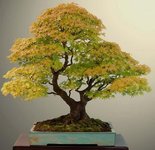Wardy940
Seedling
Hi there,
New to the site and to bonsai in general. I bought a Chinese elm a while back. Its already well established and has decent proportions so I've just been keeping it healthy and pruning to increase its ramification really.
I've been looking at get a little maple starter from herons. They're quite cheap (important because I'm young and broke haha) and I've always wanted a Japanese maple tree.
I'm just looking for some tips on how to grow these starters into nicely proportioned bonsai. I know its something that will take many years. I'm just not sure on how to get a nice, thick trunk and a good taper over the years. I'm looking for something similar to the picture over time, but of course not the same.
Thanks in advance,
New to the site and to bonsai in general. I bought a Chinese elm a while back. Its already well established and has decent proportions so I've just been keeping it healthy and pruning to increase its ramification really.
I've been looking at get a little maple starter from herons. They're quite cheap (important because I'm young and broke haha) and I've always wanted a Japanese maple tree.
I'm just looking for some tips on how to grow these starters into nicely proportioned bonsai. I know its something that will take many years. I'm just not sure on how to get a nice, thick trunk and a good taper over the years. I'm looking for something similar to the picture over time, but of course not the same.
Thanks in advance,


